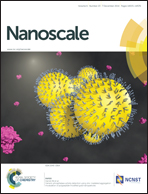Reduction-resistant and reduction-catalytic double-crown nickel nanoclusters†
Abstract
In this work, an attempt to synthesize zero-valent Ni nanoclusters using the Brust method resulted in an unexpected material, Ni6(SCH2CH2Ph)12, which is a nanoscale Ni(II)-phenylethanethiolate complex and a hexameric, double-crown-like structure, as determined by a series of characterizations, including mass spectrometry (MS), thermal gravimetric analysis (TGA), single-crystal X-ray diffraction (XRD), and X-ray photoelectron spectrometry (XPS). An interesting finding is that this complex is resistant to aqueous BH4−. Investigations into other metal-phenylethanethiolate and Ni-thiolate complexes reveal that this property is not universal and appears only in complexes with a double-crown-like structure, indicating the correlation between this interesting property and the complexes’ special structure. Another interesting finding is that the reduction-resistant Ni6(SCH2CH2Ph)12 exhibits remarkably higher catalytic activity than a well-known catalyst, Au25(SCH2CH2Ph)18, toward the reduction of 4-nitrophenol at low temperature (e.g., 0 °C). This work will help stimulate more research on the properties and applications of less noble metal nanoclusters.


 Please wait while we load your content...
Please wait while we load your content...